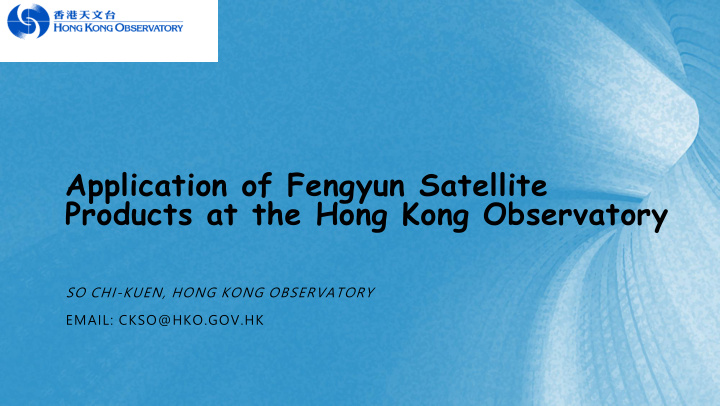



Application of Fengyun Satellite Products at the Hong Kong Observatory SO CHI-KUEN, HONG KONG OBSERVATORY EMAIL: CKSO@HKO.GOV.HK
Outlines • Introduction to Hong Kong Observatory • FY satellite reception in HKO • Data visualization and processing • Examples of FY satellite images and products • Satellite data applications • Future work on FY satellites
Introduction 1. Country overview I. Basic information of Hong Kong, China Japan • Area: 1 104 km 2 ; CHINA • Population: 7. 389 m (as of mid-2017) 22 18’N • Sub-tropical climate India HK 114 10’E II. Major historical meteorological disaster events • Typhoon and storm surge Philippines • Flooding and landslide due to severe thunderstorms and rainstorms III. Major national economic sectors relying on Met Services • The whole economy, including financial, public utilities, shipping, transportation, tourism, ...
Top hazardous weather of concern in HK (monitored by satellites) • Tropical cyclones • Aviation safety • thunderstorms • tropical cyclones • turbulence • icing • Severe thunderstorms and rainstorms • mountain wave • volcanic ash Average number of heavy rain days with hourly rainfall ≥ 30 mm in each month (1971-2000) – flooding and landslides
Fengyun Satellite Reception in HKO • Fenyun-2 Direct Reception System (since 1999) - FY-2 VISSR data • FYCast/CMACast Reception System ( since 2008/2012) - Re-broadcast satellite data from AsiaSat4, including FY2F, FY2G, FY2H, NOAA-series, MODIS, METEOSAT and GOES-series satellite data • Fengyun 4 Direct Reception System (2018) - AGRI, GIIRS, LMI Level 1 data and Level 2 Products • Fengyun3 reception enhancement (2019) - Upgrade polar orbiting satellite reception system to receive FY3B/FY3C/FY3D data in additional to NOAA, METOP, SNPP, JPSS, MODIS data
FY-2 Ground Reception System First FY2 Image received FY-2 antenna at the HKOHQ by HKO on 20 January 1999
CMACast Reception System Reception antenna at FYCast Combined Imagery HKO Headquarters
FY4 Satellite Reception System at King’s Park Met. Station in 2018
Data visualization and processing Display of satellite image all-in-one on intranet
Blended sandwich image Data visualization and processing FY4A-series images Hot tower image CI for convection development Deep convection FY4 Hybrid true colour images
Data visualization and processing FY4A RGB images Dust RGB image CI for convection development
Data visualization and processing FY3 images CI for convection development
Weather monitoring products AOD for suspended particles Tropical Cyclone and Deep Convection Monitoring LMI for thunderstorms monitoring (To enhance Indian Ocean Monitoring using FY4) monitoring High pass filter water vapour QPE for rainfall estimation CI for convection development imageries for turbulence
Satellite data applications NWP Data Assimilation :
Satellite data applications Satellite derived Reflectivity using Multi-layer perceptron artificial neural network (MLPANN) • High Temporal Resolution (10mins per snapshot) of satellite data alleviate dependent on Extrapolation • Increase accuracy in deriving motion field and short- range forecast • Provide Precipitation Observation for other regions • Ability to provide higher spatial coverage Rainfall Reflectivity Map • Period: July 2015- June 2016 (12 months) • Odd Hours • On-the-hour • Daytime • Results • POD at 24 dBZ > 70% • POD at 33 dBZ > 40%
Satellite data applications examples Satellite Nowcasting of Significant Convection and Tropical Cyclone Rapid Intensification) Convection Initiation and Rapid Developing Thunderstorm using satellite data (A) Convective Initiation (CI) Nowcasting (B) Rapid Developing Thunderstorm – Convective Warning (RDT-CW) • Analysis to identify intense or rapidly developing convective cloud cells • Cloud-free pixel Cloudy CI RDT-CW
Satellite data applications examples Satellite Nowcasting of Significant Convection and Tropical Cyclone Rapid Intensification) –cont’d Nowcasting RI of Hato
Satellite data applications examples Satellite Nowcasting of Significant Convection and Tropical Cyclone Rapid Intensification) –cont’d
Satellite data applications examples LLIS GLD360 FY4A LMI • Lightning density maps covering the Pearl River Delta region bounded by 21°N- 24°N,112°E- 116°E for the month of August 2018 based on LLIS [panel(a)], GLD360 [panel(b)] and FY4 A’s LMI [panel(c)] data. • The coloured arrows indicated the suggested displacements of the LMI lightning clusters for better matching with the LLIS and GLD360 lightning clusters patterns.
Satellite data applications examples Comparison of FY4A GIIRS and radiosonde data at 12 UTC on 3 December 2018
Future Work on Fengyun Satellites Data • Developments of more applications using FY satellite data for weather monitoring • Processing FY-3D data, e.g. retrieval of microwave sounding and profile data (with support software package from CMA), for data assimilation and nowcasting • Reception new generation of FY satellites, e.g. FY4B, and FY3E, to enhance weather monitoring and performance of regional NWP model • Explore using CMACloud to backup some essential data of CMACast
Thank You!
Recommend
More recommend